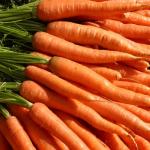Carrot and Parsnip
Best production is obtained from deep, well-drained sandy loam soils. Raised beds tend to increase the depth of tilled soil and can help provide good root shape. Some growers chisel plow before forming beds to loosen the soil and enhance root development. Do not destory soil structure by overworking soils or working them while wet. Some growers rototill to obtain a deep, friable soil. Hilling soil over the shoulders of the roots at the last cultivation can help reduce greening.
For Current information on production methods (including varieties, spacing, seeding, and fertility), weed, disease, and insect management, please visit the New England Vegetable Management Guide website.
Major disease problems in this crop:
- Alternaria Leaf Blight
- Bacterial Blight
- Black Root Rot
- Itersonilia Canker
- Potato, Scab
- Rhizoctonia Crown and Root Rot
Major insect pests that affect this crop:
The Center for Agriculture, Food and the Environment and UMass Extension are equal opportunity providers and employers, United States Department of Agriculture cooperating. Contact your local Extension office for information on disability accommodations. Contact the State Center Director’s Office if you have concerns related to discrimination, 413-545-4800 or see ag.umass.edu/civil-rights-information.
